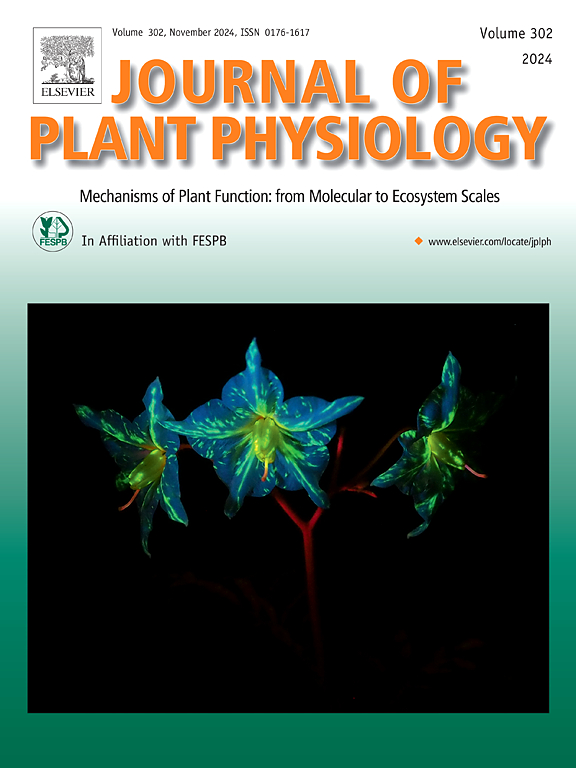增温对寒温带和北极海带(Phaeophyceae)碳收支、光合产量和生化组成的差异影响
IF 4
3区 生物学
Q1 PLANT SCIENCES
引用次数: 0
摘要
寒温带和北极硬底沿海生态系统以海带森林为主,海带森林具有高生物量产量并提供重要的生态系统服务,但由于海洋变暖而发生变化。然而,生态相关物种(如海带)对温度升高的光生理响应可能取决于种群生长的当地热环境。因此,温度对北极斯匹次卑尔根海带(Laminaria digitata, SPT)幼生孢子体生长速率、生化组成、最大量子产量、光合商和碳收支的影响;在4、10和16°C下培养),来自北海寒冷温带的Helgoland岛(HLG;在10、16和22°C下培养)进行比较分析。温度对SPT和HLG菌株的生长速率有显著影响,在10°C时生长速率最高,但在10°C和16°C时两株菌株的生长没有差异。然而,北极和寒温带L. digitata在4°C和16°C时的最大量子产量和碳固定率最高。在10°C和16°C时,相对于北极L. digitata,冷温带的产氧和固碳速率显著更高。温度和生物地理区域对光合商、溶解有机碳和颗粒有机碳的释放速率没有影响。10°C时,北极地区总碳和甘露醇含量显著高于寒温带地区,表明高纬度地区总碳和甘露醇含量增加。我们得出结论,SPT和HLG的L. digitata数据对温度升高的敏感性不同,斯匹次卑尔根岛的北极种群可能受益于海洋变暖,而Helgoland的温带种群将受到环境温度进一步升高的负面影响。本文章由计算机程序翻译,如有差异,请以英文原文为准。
Differential effects of warming on carbon budget, photosynthetic yield and biochemical composition of cold-temperate and Arctic isolates of Laminaria digitata (Phaeophyceae)
Cold-temperate and Arctic hard bottom coastal ecosystems are dominated by kelp forests, which have a high biomass production and provide important ecosystem services, but are subject to change due to ocean warming. However, the photophysiological response to increasing temperature of ecologically relevant species, such as Laminaria digitata, might depend on the local thermal environment where the population has developed. Therefore, the effects of temperature on growth rate, biochemical composition, maximum quantum yield, photosynthetic quotient and carbon budget of young cultured sporophytes of Laminaria digitata from the Arctic at Spitsbergen (SPT; cultured at 4, 10 and 16 °C) and from the cold-temperate North Sea island of Helgoland (HLG; cultured at 10, 16 and 22 °C) were comparatively analyzed. Temperature significantly affected growth rates of L. digitata from SPT and HLG, with the highest rates occurring at 10 °C, but growth did not differ between both isolates neither at 10 °C nor at 16 °C. Nevertheless, maximum quantum yield and carbon fixation rate were highest at 4 °C for the Arctic and at 16 °C for the cold-temperate L. digitata. Significantly higher rates of oxygen production and carbon fixation were observed in the cold-temperate relative to the Artic L. digitata at 10 and 16 °C, respectively. Neither temperature nor biogeographic region of origin affected the photosynthetic quotient, and release rates of dissolved or particulate organic carbon. Total carbon and mannitol content were significantly higher in the Arctic compared to the cold-temperate L. digitata at 10 °C, revealing an increased accumulation of storage compounds in the high latitude L. digitata. We conclude that L. digitata from SPT and HLG differ in their sensitivity to increasing temperatures and that the Arctic population from Spitsbergen is likely to benefit from ocean warming, while the temperate population from Helgoland will be negatively affected by further increases in ambient temperature.
求助全文
通过发布文献求助,成功后即可免费获取论文全文。
去求助
来源期刊

Journal of plant physiology
生物-植物科学
CiteScore
7.20
自引率
4.70%
发文量
196
审稿时长
32 days
期刊介绍:
The Journal of Plant Physiology is a broad-spectrum journal that welcomes high-quality submissions in all major areas of plant physiology, including plant biochemistry, functional biotechnology, computational and synthetic plant biology, growth and development, photosynthesis and respiration, transport and translocation, plant-microbe interactions, biotic and abiotic stress. Studies are welcome at all levels of integration ranging from molecules and cells to organisms and their environments and are expected to use state-of-the-art methodologies. Pure gene expression studies are not within the focus of our journal. To be considered for publication, papers must significantly contribute to the mechanistic understanding of physiological processes, and not be merely descriptive, or confirmatory of previous results. We encourage the submission of papers that explore the physiology of non-model as well as accepted model species and those that bridge basic and applied research. For instance, studies on agricultural plants that show new physiological mechanisms to improve agricultural efficiency are welcome. Studies performed under uncontrolled situations (e.g. field conditions) not providing mechanistic insight will not be considered for publication.
The Journal of Plant Physiology publishes several types of articles: Original Research Articles, Reviews, Perspectives Articles, and Short Communications. Reviews and Perspectives will be solicited by the Editors; unsolicited reviews are also welcome but only from authors with a strong track record in the field of the review. Original research papers comprise the majority of published contributions.
 求助内容:
求助内容: 应助结果提醒方式:
应助结果提醒方式:


